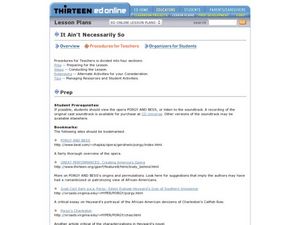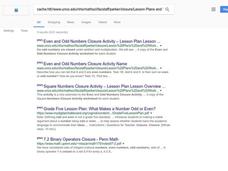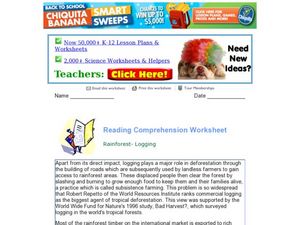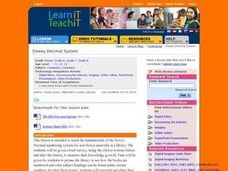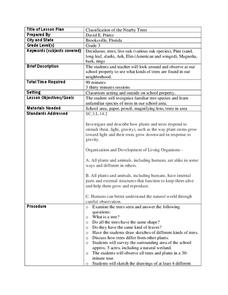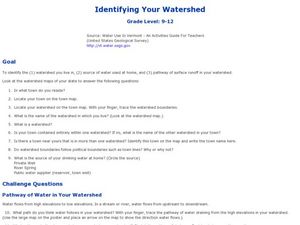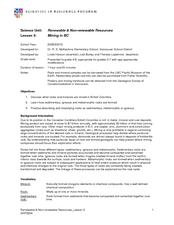Curated OER
Trumpet of the Swan
In this literature worksheet, students, after reading the book Trumpet of the Swan, survey their friends to find out who was their favorite character from the novel. Students keep a tally sheet with their findings on it.
Curated OER
Pets are Popular with U.S. Presidents
Students discuss their pets and read about pets that have lived in the White House. In this current events instructional activity, the teacher introduces the article with a vocabulary activity and pet survey, then the students read the...
Curated OER
It Ain't Necessarily So
Students examine characterization of African Americans in literature, popular culture, and opera. In this stereotypes lessons, students conduct research that requires them to analyze the origins and content of stereotypes perpetuated...
Curated OER
Even and Odd Numbers Closure Activity
Learners explore the concept of closure. In this closure lesson, students discuss what it means for something to be closed by using examples of juice and gases. Learners add and multiply combinations of even and odd numbers to...
Curated OER
Reading Comprehension: Rainforest Logging
In this reading for understanding worksheet, students read a passage about logging in the rainforest and write answers to comprehensive questions. Students write 4 short answers.
Curated OER
Beginning Graphs in MS Excel
Students practice creating graphs in Microsoft Excel. In this technology lesson, students conduct a random survey and collect data. Students use the Microsoft Excel program to create a bar graph of the data.
Curated OER
Discovering Dewey's Decimal System
Middle schoolers discover the Dewey Decimal System. In this fractions lesson plan, students utilize education software to discover how the Dewey Decimal System works. Middle schoolers create a PowerPoint presentation in groups or a...
Curated OER
Decisions, Decisions, Decisions
Students examine graphs to find the most appropriate for various kinds of data. In this graphing instructional activity, student create bar, line and circle graphs. Students create graphs electronically and manually interpreting the data.
Curated OER
Classification of the Nearby Trees
Third graders practice using classification techniques to identify local trees. In this plant life instructional activity, 3rd graders discuss how trees differ from other plants and what characteristics are unique to trees alone....
Curated OER
Distribution of children living at home
Students use E-STAT to examine demographics. In this social demographics lesson, students use statistical data to determine if a particular family is in need of assistance. Students will discuss social and educational policies and...
Curated OER
Identifying Your Watershed
Students identify the watershed where they live and how it is related to their own water consumption. In this watershed lesson students locate their watershed on their town map. The students find the source of their water that they use...
Curated OER
Renewable and Non-Renewable Resources: Mining in B.C.
Students explore energy by categorizing rocks. In this British Columbia geology lesson, students define many different vocabulary terms associated with mining such as sedimentary, igneous, and metamorphic. Students utilize sample rock...
Curated OER
Pumped Up Gas Prices
Learners calculate gas prices. In this transportation lesson, students tally the mileage and gas costs of their car for one months. They figure out how much was spent on gas and create a graph showing average gas prices over time.
Curated OER
Collect Data Using a Transect Line
Middle schoolers learn about transect lines through a study of marine debris. In this marine debris lesson, students calculate the items on a transect line and graph them. Middle schoolers complete a category worksheet.
Curated OER
Fisheries Management in the Open Ocean
Students explore biology by researching fishing equipment. For this oceanography lesson, students discuss the impact of human technology on the fish population. Students utilize marbles as a visual aide and complete fish population...
Curated OER
Cloud in the Classroom
Middle schoolers describe the relationship between animals and humans. In this biology lesson, students research about the history of horses in America. They present a mock news broadcast about their research.
Curated OER
Bouncing off the Walls
Third graders compare the bouncing height of different types of balls. In this science lesson, 3rd graders explain the importance of repeated experimentation in science. They record their result and share them with the class.
Curated OER
Follow the Falling Meteorite
Students use triangulation method to locate meteorite landing site on the map. In this earth science lesson, students participate in a meteorite treasure hunt set up by the teacher. They explain how this method is used by scientists to...
Curated OER
Know Your Boundaries: Earthquake Lessons in the Classroom
With all the recent attention on Haiti, and now Chile, it is the perfect time to teach your students about earthquakes!
Curated OER
Energy In Our Lives
First graders investigate the use of energy resources in the community. Using the tools of research and surveys in order to gather information about home and business energy usage they analyze the information in order to come up with...
Curated OER
Microsoft Office Excel
Pupils use Microsoft Office Excel. In this technology activity, students enter data on a spreadsheet using Excel. This programs tallies data and presents it using graphs.
Curated OER
What Is A Dirty Bomb?
Young scholars read an article about dirty bombs and then use a worksheet as a discussion guide to consider surrounding issues. They use balloons, cornstarch and iron fillings to demonstrate the possible impact of a dirty bomb.
Curated OER
Preparing Arguments
Students review the information from the previous lesson on persuasion essays. In groups, they brainstorm a list of arguments to use to support their trip to Six Flags. They also develop counterarguments and gather information to put...
Curated OER
Getting to Know You
Students complete a survey of interests to allow the teacher to become quickly acquainted with each student and introduce themselves using an alliterative adjective that best describes their personality.




